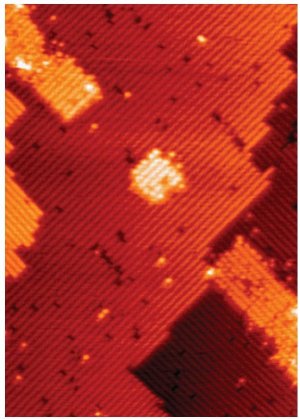May 23 2010
Scientists have literally taken a leap into a new era of computing power by making the world's smallest precision-built transistor - a "quantum dot" of just seven atoms in a single silicon crystal. Despite its incredibly tiny size - a mere four billionths of a metre long - the quantum dot is a functioning electronic device, the world's first created deliberately by placing individual atoms.
It can be used to regulate and control electrical current flow like a commercial transistor but it represents a key step into a new age of atomic-scale miniaturisation and super-fast, super-powerful computers.
 An image of the template of the quantum dot device showing a central hole where seven phosphorus atoms are incorporated. Running diagonally from top left to bottom right are the two electronic leads to connect to the dot.
An image of the template of the quantum dot device showing a central hole where seven phosphorus atoms are incorporated. Running diagonally from top left to bottom right are the two electronic leads to connect to the dot.
The discovery is reported today in the journal Nature Nanotechnology by a team from the UNSW Centre for Quantum Computer Technology (CQCT) and the University of Wisconsin-Madison.
"The significance of this achievement is that we are not just moving atoms around or looking at them through a microscope," says co-author Professor Michelle Simmons, Director of the CQCT. "We are manipulating individual atoms and placing them with atomic precision, in order to make a working electronic device.
"The Australian team has been able to fabricate an electronic device entirely out of crystalline silicon where we have replaced just seven individual silicon atoms with phosphorus atoms. That is amazing exactness.
"This is a huge technological achievement and it is a critical step to demonstrating that it is possible to build the ultimate computer - a quantum computer in silicon."
The technology for placing individual atoms on a surface, the scanning tunnelling microscope, has existed for two decades. But until now nobody has been able to use it to make atomic-precision devices capable of processing electronic inputs from the macroscopic world.
"We are testing the limits of how small an electronic device can be," Professor Simmons says. "Australia's first computer was commissioned in 1949. It took up an entire room and you could hold its components in your hands. Today you can carry a computer around in your hand and many of its components are more than 1000 times smaller than the width of a human hair.
"Now we have just demonstrated the world's first electronic device in silicon systematically created on the scale of individual atoms. This is highly significant not just for computer buffs but for all Australians. For 50 years, this process of miniaturization has been fundamental in driving productivity growth across the global economy. We have shown that this process can continue."
The team's primary goal is to create a quantum computer in silicon - an area where Australia has a unique collection of researchers and an international lead. This new device demonstrates that the technologies to enable fabrication and measurement at the atomic scale have begun to arrive.
At present, the length of a commercial transistor gate - which allows the transistor to act as an amplifier or switch for an electrical current - is about 40 nanometres (billionths of a metre). The CQCT team is now making devices with features about 10 times smaller at 4 nanometres.
It is 20 years since the world's smallest logo was made by Don Eigler and Erhard Schweizer at IBM's Almaden Research Center in San Jose, California, Professor Simmons notes. They used a scanning tunneling microscope to place 35 xenon atoms individually on a nickel surface to write the letters 'IBM'.
They ended their paper in the journal Nature with a comment that 'the possibilities for perhaps the ultimate in device miniaturization are evident', but added several notes of caution and concluded tentatively that 'the prospect of atomic-scale logic circuits and other devices is a little less remote'.
"Well, what seemed remote then is now a reality," Professor Simmons says. "We have found a way to use that microscope not simply to observe or manipulate atoms but to purposefully build with atomic precision a device with just seven atoms and it works in a real environment."